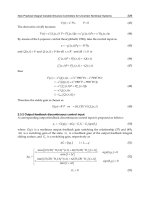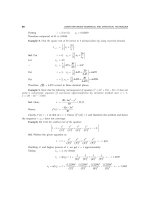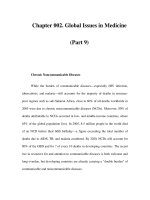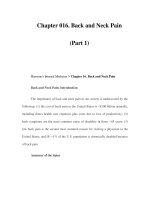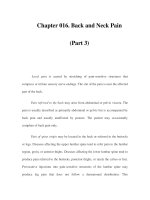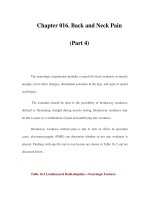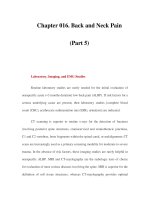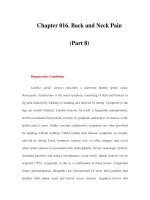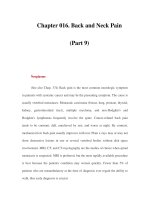Chapter 016. Back and Neck Pain (Part 9) docx
Bạn đang xem bản rút gọn của tài liệu. Xem và tải ngay bản đầy đủ của tài liệu tại đây (14.94 KB, 5 trang )
Chapter 016. Back and Neck Pain
(Part 9)
Neoplasms
(See also Chap. 374) Back pain is the most common neurologic symptom
in patients with systemic cancer and may be the presenting symptom. The cause is
usually vertebral metastases. Metastatic carcinoma (breast, lung, prostate, thyroid,
kidney, gastrointestinal tract), multiple myeloma, and non-Hodgkin's and
Hodgkin's lymphomas frequently involve the spine. Cancer-related back pain
tends to be constant, dull, unrelieved by rest, and worse at night. By contrast,
mechanical low back pain usually improves with rest. Plain x-rays may or may not
show destructive lesions in one or several vertebral bodies without disk space
involvement. MRI, CT, and CT-myelography are the studies of choice when spinal
metastasis is suspected. MRI is preferred, but the most rapidly available procedure
is best because the patient's condition may worsen quickly. Fewer than 5% of
patients who are nonambulatory at the time of diagnosis ever regain the ability to
walk, thus early diagnosis is crucial.
Infections/Inflammation
Vertebral osteomyelitis is usually caused by staphylococci, but other
bacteria or tuberculosis (Pott's disease) may be responsible. The primary source of
infection is usually the urinary tract, skin, or lungs. Intravenous drug use is a well-
recognized risk factor. Whenever pyogenic osteomyelitis is found, the possibility
of bacterial endocarditis should be considered. Back pain exacerbated by motion
and unrelieved by rest, spine tenderness over the involved spine segment, and an
elevated ESR are the most common findings in vertebral osteomyelitis. Fever or
an elevated white blood cell count is found in a minority of patients. Plain
radiographs may show a narrowed disk space with erosion of adjacent vertebrae;
however, these diagnostic changes may take weeks or months to appear. MRI and
CT are sensitive and specific for osteomyelitis; CT may be more readily available
in emergency settings and better tolerated by some patients with severe back pain.
Spinal epidural abscess (Chap. 372) presents with back pain (aggravated by
movement or palpation) and fever. Signs of nerve root injury or spinal cord
compression may be present. The abscess may track over multiple spinal levels
and is best delineated by spine MRI.
Lumbar adhesive arachnoiditis with radiculopathy is due to fibrosis
following inflammation within the subarachnoid space. The fibrosis results in
nerve root adhesions, and presents as back and leg pain associated with motor,
sensory, or reflex changes. Causes of arachnoiditis include multiple lumbar
operations, chronic spinal infections, spinal cord injury, intrathecal hemorrhage,
myelography (rare), intrathecal injection of glucocorticoids or anesthetics, and
foreign bodies. The MRI shows clumped nerve roots located centrally or adherent
to the dura peripherally, or loculations of cerebrospinal fluid within the thecal sac.
Clumped nerve roots may also occur with demyelinating polyneuropathy or
neoplastic infiltration. Treatment is usually unsatisfactory. Microsurgical lysis of
adhesions, dorsal rhizotomy, and dorsal root ganglionectomy have been tried, but
outcomes have been poor. Dorsal column stimulation for pain relief has produced
varying results. Epidural injections of glucocorticoids have been of limited value.
Metabolic Causes
Osteoporosis and Osteosclerosis
Immobilization or underlying conditions such as osteomalacia,
hyperparathyroidism, hyperthyroidism, multiple myeloma, metastatic carcinoma,
or glucocorticoid use may accelerate osteoporosis and weaken the vertebral body,
leading to compression fractures and pain. The most common causes of
nontraumatic vertebral body fractures are postmenopausal (type 1) or senile (type
2) osteoporosis (Chap. 348). Compression fractures occur in up to half of patients
with severe osteoporosis, and those who sustain a fracture have a 4.5-fold
increased risk for recurrence. The sole manifestation of a compression fracture
may be localized back pain or radicular pain exacerbated by movement and often
reproduced by palpation over the spinous process of the affected vertebra. The
clinical context, neurologic signs, and x-ray appearance of the spine establish the
diagnosis. Antiresorptive drugs including bisphosphonates (e.g., alendronate),
transdermal estrogen, and tamoxifen have been shown to reduce the risk of
osteoporotic fractures. Fewer than one-third of patients with prior compression
fractures are adequately treated for osteoporosis despite the increased risk for
future fractures; rates of primary prevention among individuals at risk, but without
a history of fracture, are even less. Compression fractures above the midthoracic
region suggest malignancy; if tumor is suspected, a bone biopsy or diagnostic
search for a primary tumor is indicated. For a complete discussion of diagnosis
and management of osteoporosis, see Chap. 348.
Interventions [percutaneous vertebroplasty (PVP), kyphoplasty] exist for
osteoporotic compression fractures associated with debilitating pain. Candidates
for PVP have midline back pain, palpation tenderness over the spinous process of
the affected vertebral body, <80% loss of vertebral body height, and onset of
symptoms within the prior 4 months. The PVP technique consists of injection of
polymethylmethacrylate, under fluoroscopic guidance, into the affected vertebral
body. Kyphoplasty adds the inflation of a balloon in the vertebral body prior to the
injection of cement. Rare complications can include extravasation of cement into
the epidural space (resulting in myelopathy) or fatal pulmonary embolism from
migration of cement into paraspinal veins. Approximately three-quarters of
patients who meet selection criteria have reported enhanced quality of life. Relief
of pain following PVP has also been reported in patients with vertebral metastases,
myeloma, or hemangiomas.
Osteosclerosis, an abnormally increased bone density often due to Paget's
disease, is readily identifiable on routine x-ray studies and may or may not
produce back pain. Spinal cord or nerve root compression may result from bony
encroachment. For further discussion of these bone disorders, see Chaps. 347, 348,
and 349.
